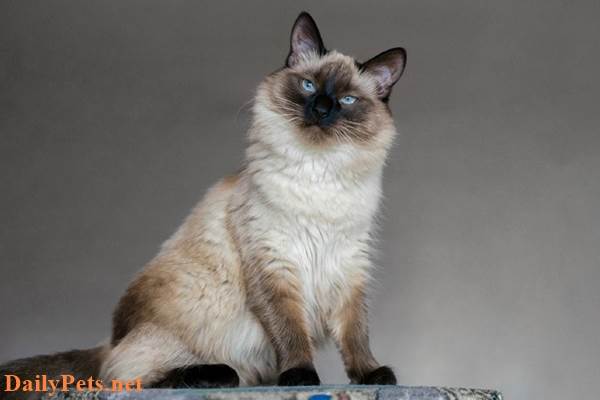Let’s go to DailyPets.net to learn more about the cat’s tail and the meaning of the cat’s tail through this article.
What is a tail?
The tail is an external extension of an animal’s body, which continues from the vertebrae and is covered by muscles and skin. In breeds with dense fur, the tail is large due to the presence of long, thick fur and an undercoat. Short-haired cats have a less furry tail, but they still bear fur. Some cats are completely hairless, resulting in a smoother tail that might resemble a rat’s tail in appearance.

What does a cat’s tail mean?
The tail typically measures 25–28 cm in adult cats and comprises 19–23 vertebral discs. It contains a high concentration of nerve endings, making it a sensitive area that cats usually dislike touching. The tail’s nervous system is intricately connected to the cat’s legs and head. Severe tail injuries can lead to numbness in the hind limbs, which may result in issues like urinary incontinence and significant pain in the legs and spine. These complications can lead to the cat’s deterioration and potentially even death. It’s crucial to avoid pulling or bending a cat’s tail, as it is an essential part of its body.
The Tail as a Lever and Balancer
When a cat jumps, it consistently lands precisely where intended. This accuracy is aided by its tail. By moving its tail in either direction, the cat can adjust its body’s position mid-jump, ensuring it lands exactly where planned. The tail serves as a guide for body orientation during these movements.
The cat’s tail complements its soft paws and sharp claws while navigating narrow surfaces like fences, curbs, or chair backs. It functions like a tightrope walker’s pole, allowing the cat to balance and move gracefully. The tail’s movement—lifting, lowering, freezing—creates an illusion of stillness, enhancing the cat’s balance.
During hunting activities, such as pursuing mice, moles, or birds, the cat’s tail aids in swiftly changing its movement trajectory. It adjusts its body’s position and the tail’s movement to catch prey mid-air. Although this occurs rapidly, the cat’s coordination is remarkable.
Graceful Tailless Cats
Cats born without tails like the Isle of Man breed lacking the tail growth gene- maintain grace and agility. Their well-developed hind leg muscles compensate for the missing tail’s assistance. These cats can remain accurate and are less prone to fleeing from predators. Although cats that lose their tails due to injury might face challenges, they adapt and strengthen their hind legs over time, enabling them to jump, run, and climb.
The Tail’s Role in Regulating Temperature
The tail’s unconventional use aids the cat’s temperature regulation. Unlike other animals, a cat’s tail isn’t primarily for warding off insects but for creating ventilation. On hot days, the cat may flick its tail to generate a gentle breeze and allow air to cool it down. The air passing over the tail contributes to overall cooling as the cat moves.
In colder weather, the cat curls into a ball, using its tail to cover its nose, ears, and muzzle like a heating pad. However, bald cats lack insulating fur, limiting their tail’s effectiveness in preserving warmth.
The Emotional Significance of the Tail
A cat’s tail serves as an emotional indicator. The cat might thump its tail on the floor when annoyed or angry, progressing to more forceful thwacks if extremely displeased. A slightly twitching tail signals a cat’s willingness to engage and be petted. During mealtime, the cat circles the owner, rubbing against their legs with an erect tail that may sway gently.

When frightened or highly agitated, the cat’s fur—including its tail—stands on end. The tail sticks straight up, and in extreme cases of readiness to attack, it may be lowered and tapped on the ground as a warning before potential aggression.
Observing these behaviors provides insights into a cat’s emotions and desires. If a cat’s tail appears limp and lethargic, it’s a sign of illness, warranting immediate attention from a veterinarian.
The Crucial Role of the Tail
Cats rely on their tails to maintain agility and swiftness. The tail adds elegance and grace to the cat’s physique, aiding in jumping and functioning as a steering and balancing tool. It plays a vital role in temperature regulation, helping the cat stay cool or warm as needed. Moreover, the tail is a powerful communicator of a cat’s emotions and intentions. Thus, the tail stands as an integral and irreplaceable component in the lives of these incredible and remarkably beautiful animals.
Cat tail movement meaning
You may not know the tail position reveals the cat’s mood:
- When a cat’s tail is upright, they are confident, excited, or pleased. Cats often uprightly greet their owners with their tails to show their happy mood.
- Like a question mark, an upright cat tail with a curve at the end is friendly or amusing. This action occurs when the cat is playing with a favorite toy.
- When a cat is uncertain about a situation or is aggressive, it will keep its tail low near the ground. However, some cat breeds, like the Persian and the Scottish Fold, tend to keep their tails low even in a good mood.
- If the cat focuses on a particular object, it will flick its tail from side to side, for example, when it sees an insect or a toy. This action usually occurs right before they grab something.
- If excited or scared, the cat flicks its tail to the ground. It will show aggression soon after.
- When a cat’s tail is ruffled, it means they are scared. They make their tails bigger to repel something (like a threat).
- The tail hidden underneath the body indicates that the cat is scared and uncertain or something in the environment makes it uncomfortable.
- Cats flutter their tails to express joy or predict something good is about to happen. Many owners report that their cats often do this before being fed.





